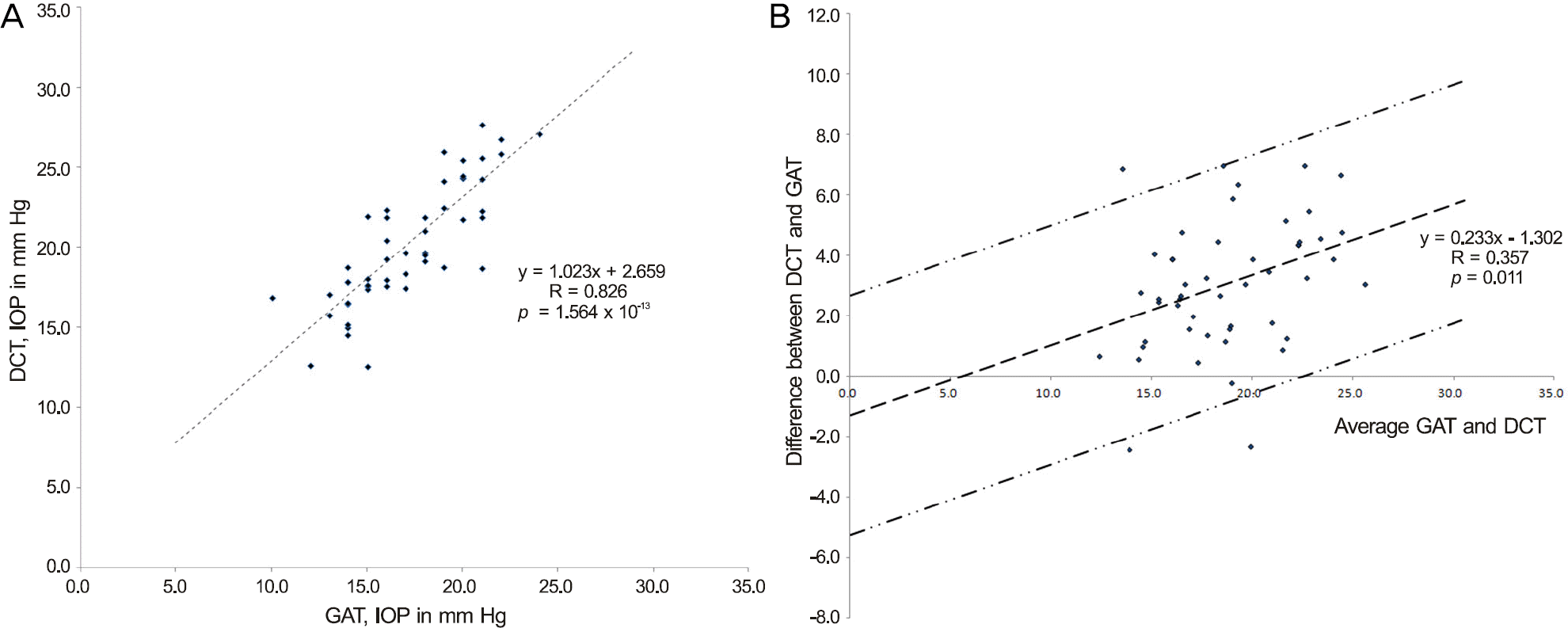1. Flammer J, Orgül S, Costa VP. . The impact of ocular blood flow in glaucoma. Prog Retin Eye Res. 2002; 21:359–93.

2. Dastiridou AI, Tsironi EE, Tsilimbaris MK. . Ocular rigidity, outflow facility, ocular pulse amplitude, and pulsatile ocular blood flow in open-angle glaucoma: a manometric study. Invest Ophthalmol Vis Sci. 2013; 54:4571–7.

3. Mousa AR, Bredeţ ean V, Costin D. The role of ocular perfusion pressure in the course of primary open angle glaucoma in patients with systemic hypertension. Rev Med Chir Soc Med Nat Iasi. 2012; 116:162–7.
4. Dastiridou Al, Ginis HS, De Brouwere D. . Ocular rigidity, oc-ular pulse amplitude, and pulsatile ocular blood flow: the effect of intraocular pressure. Invest Ophthalmol Vis Sci. 2009; 50:5718–22.

5. Bertelmann T, Langanke S, Potstawa M, Strempel I. Can dynamic contour tonometry and ocular pulse amplitude help to detect severe cardiovascular pathologies? Clin Ophthalmol. 2014; 8:1317–21.
6. Ehongo A, de Maertelaer V, Cullus P, Pourjavan S. Correlation be-tween corneal hysteresis, corneal resistance factor, and ocular pulse amplitude in healthy subjects. J Fr Ophthalmol. 2008; 31:999–1005.
7. Villas-Bôas FS, Doi LM, Sousa AK, Melo LA Jr. Correlation be-tween diurnal variation of intraocular pressure, ocular pulse ampli-tude and corneal structural properties. Arq Bras Oftalmol. 2009; 72:296–301.

8. Katsimpris JM, Theoulakis PE, Papadopoulos GE. . Ocular pulse amplitude measurement using pascal dynamic contour ton-ometer in glaucoma patients. Klin Monbl Augenheilkd. 2014; 231:363–7.

9. Figueiredo BP, Cronemberger S, Kanadani FN. Correlation be-tween ocular perfusion pressure and ocular pulse amplitude in glaucoma, ocular hypertension, and normal eyes. Clin Ophthalmol. 2013; 7:1615–21.

10. Medeiros FA, Weinreb RN. Evaluation of the influence of corneal biomechanical properties on intraocular pressure measurements using the ocular response analyzer. J Glaucoma. 2006; 15:364–70.

11. Kaufmann C, Bachmann LM, Thiel MA. Comparison of dynamic contour tonometry with goldmann applanation tonometry. Invest Ophthalmol Vis Sci. 2004; 45:3118–21.

12. Dastiridou AI, Ginis HS, De Brouwere D. . Ocular rigidity, oc-ular pulse amplitude, and pulsatile ocular blood flow: the effect of intraocular pressure. Invest Ophthalmol Vis Sci. 2009; 50:5718–22.

13. Kaufmann C, Bachmann LM, Robert YC, Thiel MA. Ocular pulse amplitude in healthy subjects as measured by dynamic contour tonometry. Arch Ophthalmol. 2006; 124:1104–8.

14. Hsu SY, Sheu MM, Hsu AH. . Comparisons of intraocular pressure measurements: Goldmann applanation tonometry, non-contact tonometry, Tono-Pen tonometry, and dynamic contour tonometry. Eye (Lond). 2009; 23:1582–8.

15. Silver DM, Geyer O. Pressure-volume relation for the living hu-man eye. Curr Eye Res. 2000; 20:115–20.

16. De Moraes CG, Reis AS, Cavalcante AF. . Choroidal ex-pansion during the water drinking test. Graefes Arch Clin Exp Ophthalmol. 2009; 247:385–9.

17. De Moraes CG, Hill V, Tello C. . Lower corneal hysteresis is associated with more rapid glaucomatous visual field progression. J Glaucoma. 2012; 21:209–13.

18. Bochmann F, Ang GS, Azuara-Blanco A. Lower corneal hysteresis in glaucoma patients with acquired pit of the optic nerve (APON). Graefes Arch Clin Exp Ophthalmol. 2008; 246:735–8.

19. del Buey MA, Cristóbal JA, Ascaso FJ. . Biomechanical prop-erties of the cornea in Fuchs' corneal dystrophy. Invest Ophthalmol Vis Sci. 2009; 50:3199–202.

20. Wegner W. New results about the pulsatile variations of the human bulbus and eye socket. Arch Augenheilkd. 1930; 102:1–32.
21. Kaufmann C, Bachmann LM, Robert YC, Thiel MA. Ocular pulse amplitude in healthy subjects as measured by dynamic contour tonometry. Arch Ophthalmol. 2006; 124:1104–8.

22. Kotecha A, White E, Schlottmann PG, Garway-Heath DF. Intraocular pressure measurement precision with the Goldmann applanation, dynamic contour, and ocular response analyzer tonometers, Ophthalmology. 2010; 117:730–7.
23. Bolivar G, Javier Paz Moreno-Arrones, Teus MA. Cornea and Glaucoma. Rumelt S, editor. Glaucoma-basic and clinical aspects. 1st. Rijeka: InTech;2013. chap. 11.

24. Gordon MO, Beiser JA, Brandt JD. . The Ocular Hypertension Treatment Study: baseline factors that predict the onset of primary open-angle glaucoma. Arch Ophthalmol. 2002; 120:714–20.
25. Burgoyne CF, Downs JC, Bellezza AJ. . The optic nerve head as a biomechanical structure: a new paradigm for understanding the role of IOP-related stress and strain in the pathophysiology of glaucomatous optic nerve head damage. Prog Retin Eye Res. 2005; 24:39–73.

26. Lesk MR, Hafez AS, Descovich D. Relationship between central corneal thickness and changes of optic nerve head topography and blood flow after intraocular pressure reduction in open-angle glau-coma and ocular hypertension. Arch Ophthalmol. 2006; 124:1568–72.

27. Rhew JY, Choi KR. Corneal biomechanical properties of normal tension glaucoma in young patients evaluated with the ocular re-sponse analyzer. J Korean Ophthalmol Soc. 2013; 54:280–8.

28. Francis BA, Hsieh A, Lai MY. . Effects of corneal thickness, corneal curvature, and intraocular pressure level on Goldmann ap-planation tonometry and dynamic contour tonometry. Ophthalmology. 2007; 114:20–6.

29. Martinez-de-la-Casa JM, Garcia-Feijoo J, Vico E. . Effect of corneal thickness on dynamic contour, rebound, and goldmann tonometry. Ophthalmology. 2006; 113:2156–62.

30. McBrien NA, Gentle A. Role of the sclera in the development and pathological complications of myopia. Prog Retin Eye Res. 2003; 22:307–38.

31. Avetisov ES, Savitskaya NF. Some features of ocular micro-circulation in myopia. Ann Ophthalmol. 1977; 9:1261–4.
32. Plakitsi A, O'Donnell C, Miranda MA. . Corneal biomechanical properties measured with the Ocular Response Analyser in a my-opic population. Ophthalmic Physiol Opt. 2011; 31:404–12.

33. Roberts CJ, Reinstein DZ, Archer TJ. . Comparison of ocular biomechanical response parameters in myopic and hyperopic eyes using dynamic bidirectional applanation analysis. J Cataract Refract Surg. 2014; 40:929–36.

34. Kim SW, Seo SG, Her J, Park SJ. Factors affecting the ocular re-sponse analyzer parameters in normal Korean. J Korean Ophthalmol Soc. 2009; 50:1605–10.

35. Elsheikh A, Wang D, Brown M. . Assessment of corneal bio-mechanical properties and their variation with age. Curr Eye Res. 2007; 32:11–9.







 PDF
PDF ePub
ePub Citation
Citation Print
Print


 XML Download
XML Download